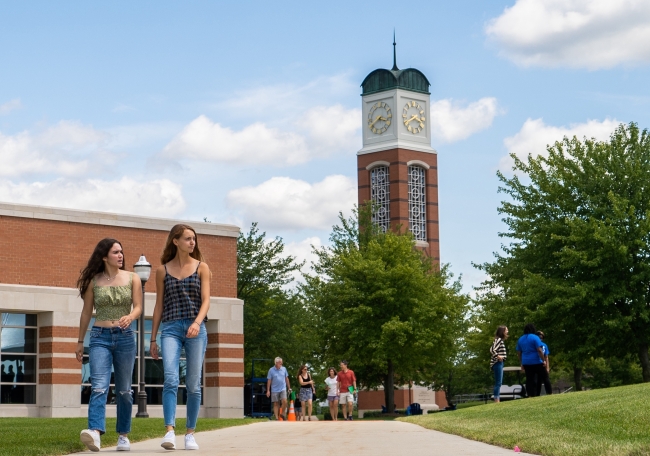You have /5 articles left.
Sign up for a free account or log in.

Grand Valley State University is expanding its online offerings in a new hybrid program called Omni.
Grand Valley State University
Kara Van Dam spent her career’s first two decades at institutions now synonymous with online learning, including the University of Maryland Global Campus and Kaplan University.
But over the years, she began to realize learning limitations can emerge when students never step into a real-world classroom.
“I became enamored with the power of place-based education with online degrees,” Van Dam said.
Across the country in Allendale, Mich., Philomena Mantella felt the same.
“I was inspired by campuses that were underutilized as platforms,” said Mantella, president at Grand Valley State University. “They were great places for community events and offerings but were not creating a platform for continuous learning.”
Now the two have teamed up to launch what they call a first-of-its-kind hybrid program within Grand Valley State University—with an ambitious mission of reaching 50,000 students in the first five years.
“It’s a bold goal. It’s a high impact goal,” Mantella said. “But we’re committed to it and not afraid to say it.”
The program is the latest in a growing number of state initiatives to help adult learners. Half of Michigan’s adult population—those 25 years old and older—do not have a post-secondary degree, and another 2 million have some college but no degree. For many years, institutions have zeroed in on adult learners by offering online degrees, which are seen as more flexible for those working and often parenting.
Other states have begun similar efforts, albeit in a more centralized, state-led manner. North Carolina-based ncIMPACT and myFutureNC partnered in 2018 to launch a pilot program focused on 15 educational-focused collaborations, all focused on boosting the number of students attaining degrees, credentials or certifications. Similarly, the Massachusetts Legislature in 2013 launched its “Bridges to College” initiative focused on increasing underrepresented adults in post-secondary programs.
A New Type of Online Offering
While GVSU has traditional online offerings, the new hybrid program—named Omni, the Latin word for ‘all’—will expand this fall across the university’s five campuses.
The university hopes to help 10,000 Michiganders obtain degrees in the next five years, with an additional 40,000 receiving some type of upskilling by earning a certificate or credential. In comparison, the university’s brick-and-mortar classroom serves roughly 23,000 students.
“Proximity matters and access matters,” said Van Dam, now the chief executive of GVSU Omni. “What has happened in this educational space is we need working adults with degrees, and it becomes, ‘Let’s put everything online.’ While it’s true they need the flexibility of online programs, sometimes you need a face-to-face option, whether it’s in the classroom or for outside support.”
However, it’s also important for institutions to look beyond just more course offerings—whether online, hybrid, or brick and mortar—and understand the root causes for why adult learners are not getting degrees, said Matt DeMonbrun, research director of the Michigan Center for Adult College Success.
“We think it’s all about access, and online is the easiest way to access,” he said. “But it’s often a myriad of barriers that add up: it’s access and financial and childcare and wage loss. We’re encouraging a lot of our colleges to tap into the barriers and either eliminate or try to understand them.”
The program is an expansion to GVSU’s existing slate, which spanned 60 noncredit offerings such as badges or certificates.
The amount of in-person versus online classes a student takes depends on their preferences and needs, varying by student.
For the Omni program, the distribution of GVSU’s locations means that every adult in Michigan’s lower peninsula is within 100 miles of a campus.
While some of the programs, such as a degree in Applied Sciences, will be available across campuses, there will be a focus on place-based programs unique to each campus, such as a focus on mobility in Detroit. The university’s Traverse City campus, in the rural area of Northern Michigan, will focus on rural health care.
“We’re being very intentionally aligned to where the local opportunities and jobs are,” said Van Dam. “We want to make sure as they get their education, that gets them a job and keeps them in the community.”
Student David Buchanan will begin training at the Traverse City campus this fall to become a physician’s assistant. The 28-year-old father is balancing work as a nursing assistant while attending school. Buchanan said the ability to work in his own backyard is a plus for the program, in addition to the flexibility of partially online courses.
“As a father, husband and a steward of my community, sometimes it can be very difficult to attend school, work and do everything to better myself and my community,” he said. “They allow flexibility, convenience and still give you the ability to collaborate with your peers.”
The new program comes as most institutions worry about a looming enrollment cliff, with fewer students expected to head to college.
“The enrollment cliff [fear] is true if you stay in your same lane in the market, [it is] not if you are approaching it in new ways,” Mantella said.
Other Michigan initiatives
Part of Michigan’s lower degree attainment may be due to local industries relying on trade skills.
“The problem is they get to the point of getting a job but can’t get upward mobility; they don’t have the credential that’s needed,” DeMonbrun said.
DeMonbrun’s Michigan Center for Adult College Success, founded last March, is one of several initiatives in the state to boost adult learners. Michigan ranks 37th in the nation for college attainment, lower than its neighboring states.
Michigan Governor Gretchen Whitmer launched the “Sixty by 30” plan in 2018, with the goal of having 60 percent of adults in the state obtain a degree or certificate by 2030. That number is currently at 51.1 percent.





